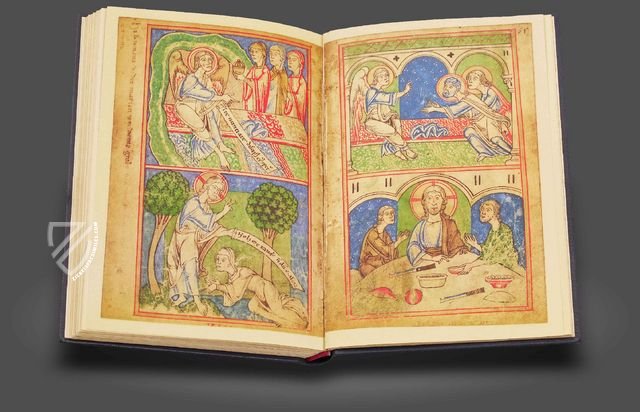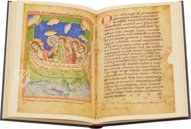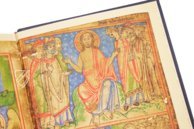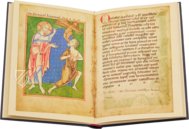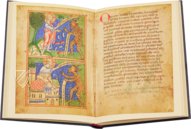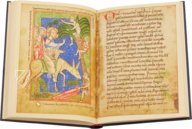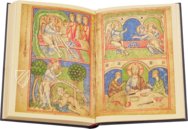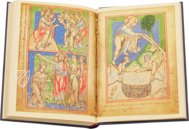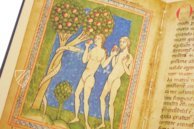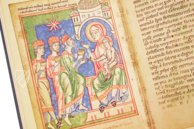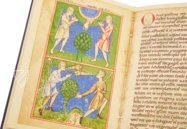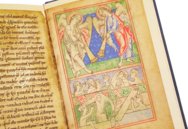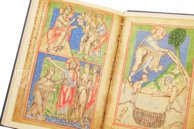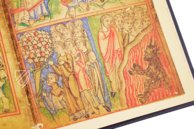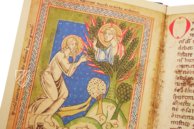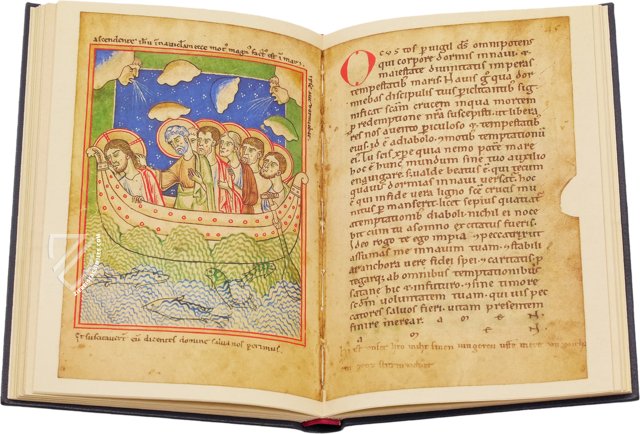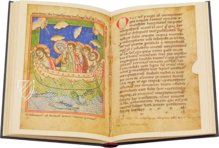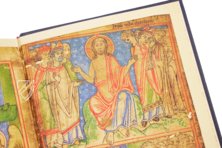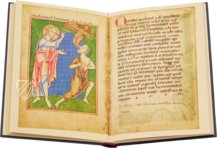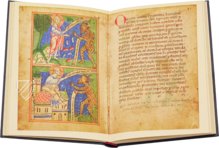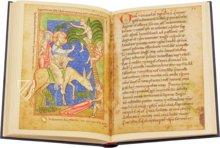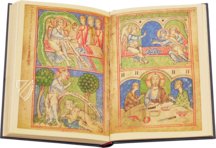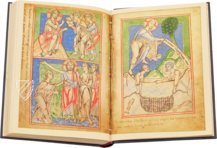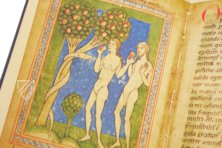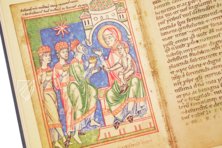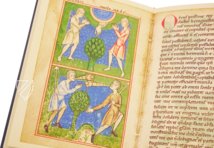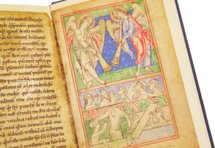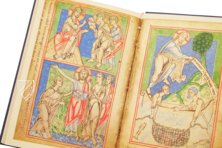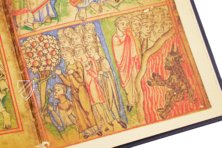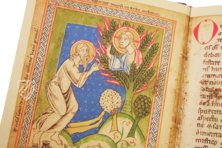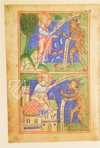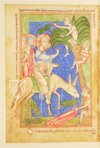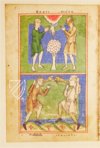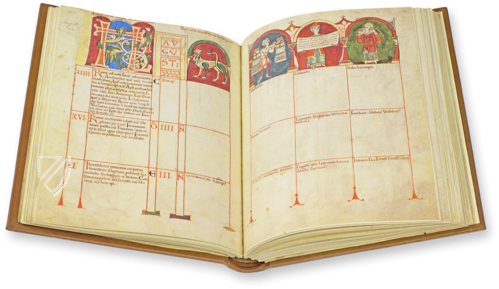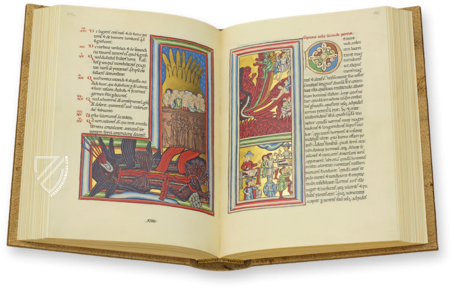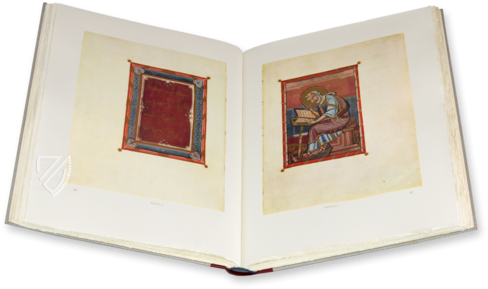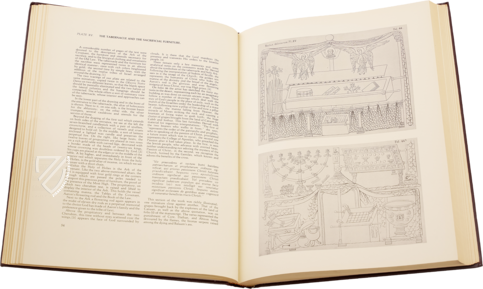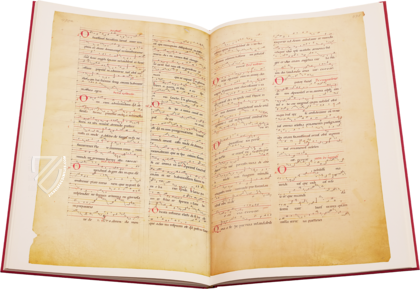Saint Hildegard's Prayer Book
(1,000€ - 3,000€)
Among medieval prayer books, the Liber precatorius of the Bavarian State Library, which was produced in the Middle Rhine region ca. 1175, is distinguished both by the abundance of its illuminations and for their extraordinary quality and iconographic specificity. 72 gorgeous miniatures accompany the individual prayers: while some depict Old Testament scenes from the Creation story to the Ten Commandments, and others relate to New Testament events, an image of the Last Judgment forms the culminating conclusion. Aside from the importance of the prayers and the unique image sequence related to them, the manuscript is distinguished for supposedly being the personal prayer book of the famous abbess, writer, composer, philosopher, Christian mystic, visionary, and botanist Hildegard von Bingen.
Saint Hildegard's Prayer Book
This precious manuscript from the Bavarian State Library is believed to have been the personal possession of one of the most famous women of the entire Middle Ages: Hildegard von Bingen (1098–1179). Written mainly in Latin, the sumptuous design and selection of prayers indicates that the Liber precatorius was intended for a high-ranking woman and was likely created by a Cistercian monk who collaborated with a miniaturist familiar with both older theological traditions and the new ideas of the 12th century, a time of reform and innovation in the church.
An Unusual Prayer Book
This manuscript is unusual and only one other surviving work shares its image program and salvation-historical perspective, the structure of which expresses more than just the intention to convey a biblical completeness but allows the reader to reflect on the course of the world and their own existence in it. The 72 miniatures chronologically traces the history of piety from Genesis to the Last Judgement including a detailed depiction of Christ's ministry. It is designed to allow the reader to contemplate the salvific events and create a meditative relationship with them. For example, the miniature on the theme of the carrying of the cross shows Christ embracing a heavy, large cross standing on the ground, but it is not the actual carrying of the cross that is emphasized, but rather Christ's willingness to take up the cross and begin the path of suffering. It thus shifts the emphasis from the historical event to the inner process of the action. The cross is also associated with the tree of life, especially in the depiction of the Last Judgement.
Origins of the Manuscript
Judging by the iconography, the manuscript probably originated in Trier, perhaps in the monastery of St. Eucharius, which Hildegard would have had regular contact with. German texts were added sometime in the first half of the 13th century to explain the illustrations accompanying two of the Marian prayers, one of which was crossed out with ink by a later hand, which has been a considerable obstacle for researchers. Nonetheless, a linguistic analysis indicates that the notes were written in an Alemannic dialect, i.e. the southwestern linguistic German area. It is thus believed that these notes were added by nuns from the region of Bingen-Worms, which is not far from the convent founded by Hildegard at Rupertsberg.
Codicology
- Alternative Titles
- Gebetbuch der Hildegard von Bingen
Hildegard-Gebetbuch
Series precum ad singula Dei et Christi opera, quae figuris pictis repraesentantur, se referentium
Saint Hildegard's Prayer Book
Book of Hours of Hildegard von Bingen - Size / Format
- 144 pages / 17.0 × 11.5 cm
- Origin
- Germany
- Date
- Ca. 1175–1180 or first half of the 13th century
- Epochs
- Style
- Genre
- Language
- Illustrations
- 72 fulll-page miniatures; decorated initals
- Artist / School
- Hildegard von Bingen (1098– 1179) (author)
Saint Hildegard's Prayer Book
The Temptation of Christ
After his baptism by John the Baptist, Jesus went to the Judean Desert to fast for 40 days and nights, during which time he was tempted by Satan three times. The lower register of this page shows the temptation on the pinnacle of the temple, assumed to be the Temple Mount in Jerusalem. Seated on a tile roof over the entrance, Jesus maintains his integrity in the face of Satan’s challenges, saying: “It is written again, ‘You shall not tempt the LORD your God.’” (Matt. 4:7)

Saint Hildegard's Prayer Book
Entry into Jerusalem
Commemorated today on Palm Sunday, Christ’s triumphal entry into Jerusalem marks the beginning of the Passion cycle. Accompanied by his Disciples, Christ is depicted riding on a donkey, which symbolizes peace in contrast to a horse, and giving the sign of the benediction while dressed in flowing garments.
The citizens of Jerusalem have come out to meet him on the road, some lay their clothes on the ground while others climb a palm tree to retrieve branches. They are depicted as being small and childlike in comparison to the figures in the oncoming procession but are depicted with natural bodies and expressive faces: e.g., the figure dressed in red climbing the tree looks frustrated or perhaps impatient to get a glimpse of the Son of God.
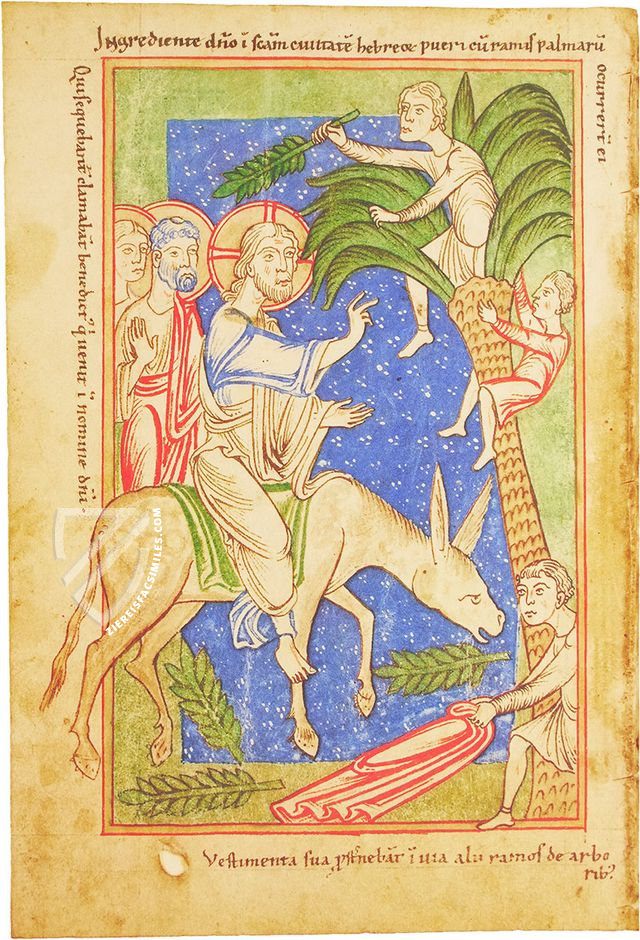
#1 Hildegard-Gebetbuch
Language: German
(1,000€ - 3,000€)
- Treatises / Secular Books
- Apocalypses / Beatus
- Astronomy / Astrology
- Bestiaries
- Bibles / Gospels
- Chronicles / History / Law
- Geography / Maps
- Saints' Lives
- Islam / Oriental
- Judaism / Hebrew
- Single Leaf Collections
- Leonardo da Vinci
- Literature / Poetry
- Liturgical Manuscripts
- Medicine / Botany / Alchemy
- Music
- Mythology / Prophecies
- Psalters
- Other Religious Books
- Games / Hunting
- Private Devotion Books
- Other Genres
- Afghanistan
- Armenia
- Austria
- Belgium
- Belize
- Bosnia and Herzegovina
- China
- Colombia
- Costa Rica
- Croatia
- Cyprus
- Czech Republic
- Denmark
- Egypt
- El Salvador
- Ethiopia
- France
- Germany
- Greece
- Guatemala
- Honduras
- Hungary
- India
- Iran
- Iraq
- Israel
- Italy
- Japan
- Jordan
- Kazakhstan
- Kyrgyzstan
- Lebanon
- Liechtenstein
- Luxembourg
- Mexico
- Morocco
- Netherlands
- Palestine
- Panama
- Peru
- Poland
- Portugal
- Romania
- Russia
- Serbia
- Spain
- Sri Lanka
- Sweden
- Switzerland
- Syria
- Tajikistan
- Turkey
- Turkmenistan
- Ukraine
- United Kingdom
- United States
- Uzbekistan
- Vatican City
- A. Oosthoek, van Holkema & Warendorf
- Aboca Museum
- Ajuntament de Valencia
- Akademie Verlag
- Akademische Druck- u. Verlagsanstalt (ADEVA)
- Aldo Ausilio Editore - Bottega d’Erasmo
- Alecto Historical Editions
- Alkuin Verlag
- Almqvist & Wiksell
- Amilcare Pizzi
- Andreas & Andreas Verlagsbuchhandlung
- Archa 90
- Archiv Verlag
- Archivi Edizioni
- Arnold Verlag
- ARS
- Ars Magna
- ArtCodex
- AyN Ediciones
- Azimuth Editions
- Badenia Verlag
- Bärenreiter-Verlag
- Belser Verlag
- Belser Verlag / WK Wertkontor
- Benziger Verlag
- Bernardinum Wydawnictwo
- BiblioGemma
- Biblioteca Apostolica Vaticana (Vaticanstadt, Vaticanstadt)
- Bibliotheca Palatina Faksimile Verlag
- Bibliotheca Rara
- Boydell & Brewer
- Bramante Edizioni
- Bredius Genootschap
- Brepols Publishers
- British Library
- C. Weckesser
- Caixa Catalunya
- Canesi
- CAPSA, Ars Scriptoria
- Caratzas Brothers, Publishers
- Carus Verlag
- Casamassima Libri
- Centrum Cartographie Verlag GmbH
- Chavane Verlag
- Christian Brandstätter Verlag
- Circulo Cientifico
- Club Bibliófilo Versol
- Club du Livre
- CM Editores
- Collegium Graphicum
- Collezione Apocrifa Da Vinci
- Comissão Nacional para as Comemorações dos Descobrimentos Portugueses
- Coron Verlag
- Corvina
- CTHS
- D. S. Brewer
- Damon
- De Agostini/UTET
- De Nederlandsche Boekhandel
- De Schutter
- Deuschle & Stemmle
- Deutscher Verlag für Kunstwissenschaft
- DIAMM
- Droz
- E. Schreiber Graphische Kunstanstalten
- Ediciones Boreal
- Ediciones Grial
- Ediclube
- Edições Inapa
- Edilan
- Editalia
- Edition Deuschle
- Edition Georg Popp
- Edition Leipzig
- Edition Libri Illustri
- Editiones Reales Sitios S. L.
- Éditions de l'Oiseau Lyre
- Editions Medicina Rara
- Editorial Casariego
- Editorial Mintzoa
- Editrice Antenore
- Editrice Velar
- Edizioni Edison
- Egeria, S.L.
- Eikon Editores
- Electa
- Emery Walker Limited
- Enciclopèdia Catalana
- Eos-Verlag
- Ephesus Publishing
- Ernst Battenberg
- Eugrammia Press
- Extraordinary Editions
- Fackelverlag
- Facsimila Art & Edition
- Facsimile Editions Ltd.
- Facsimilia Art & Edition Ebert KG
- Faksimile Verlag
- Feuermann Verlag
- Folger Shakespeare Library
- Franco Cosimo Panini Editore
- Friedrich Wittig Verlag
- Fundación Hullera Vasco-Leonesa
- G. Braziller
- Gabriele Mazzotta Editore
- Gebr. Mann Verlag
- Gesellschaft für graphische Industrie
- Getty Research Institute
- Giovanni Domenico de Rossi
- Giunti Editore
- Graffiti
- Grafica European Center of Fine Arts
- Guido Pressler
- Guillermo Blazquez
- Gustav Kiepenheuer
- H. N. Abrams
- Harrassowitz
- Harvard University Press
- Helikon
- Hendrickson Publishers
- Henning Oppermann
- Herder Verlag
- Hes & De Graaf Publishers
- Hoepli
- Holbein-Verlag
- Houghton Library
- Hugo Schmidt Verlag
- Idion Verlag
- Il Bulino, edizioni d'arte
- ILte
- Imago
- Insel Verlag
- Insel-Verlag Anton Kippenberger
- Instituto de Estudios Altoaragoneses
- Instituto Nacional de Antropología e Historia
- Introligatornia Budnik Jerzy
- Istituto dell'Enciclopedia Italiana - Treccani
- Istituto Ellenico di Studi Bizantini e Postbizantini
- Istituto Geografico De Agostini
- Istituto Poligrafico e Zecca dello Stato
- Italarte Art Establishments
- Jan Thorbecke Verlag
- Johnson Reprint Corporation
- Josef Stocker
- Josef Stocker-Schmid
- Jugoslavija
- Karl W. Hiersemann
- Kasper Straube
- Kaydeda Ediciones
- Kindler Verlag / Coron Verlag
- Kodansha International Ltd.
- Konrad Kölbl Verlag
- Kurt Wolff Verlag
- La Liberia dello Stato
- La Linea Editrice
- La Meta Editore
- Lambert Schneider
- Landeskreditbank Baden-Württemberg
- Leo S. Olschki
- Les Incunables
- Liber Artis
- Library of Congress
- Libreria Musicale Italiana
- Lichtdruck
- Lito Immagine Editore
- Lumen Artis
- Lund Humphries
- M. Moleiro Editor
- Maison des Sciences de l'homme et de la société de Poitiers
- Manuscriptum
- Martinus Nijhoff
- Maruzen-Yushodo Co. Ltd.
- MASA
- Massada Publishers
- McGraw-Hill
- Metropolitan Museum of Art
- Militos
- Millennium Liber
- Müller & Schindler
- Nahar - Stavit
- Nahar and Steimatzky
- National Library of Wales
- Neri Pozza
- Nova Charta
- Oceanum Verlag
- Odeon
- Orbis Mediaevalis
- Orbis Pictus
- Österreichische Staatsdruckerei
- Oxford University Press
- Pageant Books
- Parzellers Buchverlag
- Patrimonio Ediciones
- Pattloch Verlag
- PIAF
- Pieper Verlag
- Plon-Nourrit et cie
- Poligrafiche Bolis
- Presses Universitaires de Strasbourg
- Prestel Verlag
- Princeton University Press
- Prisma Verlag
- Priuli & Verlucca, editori
- Pro Sport Verlag
- Propyläen Verlag
- Pytheas Books
- Quaternio Verlag Luzern
- Reales Sitios
- Recht-Verlag
- Reichert Verlag
- Reichsdruckerei
- Reprint Verlag
- Riehn & Reusch
- Roberto Vattori Editore
- Rosenkilde and Bagger
- Roxburghe Club
- Salerno Editrice
- Saltellus Press
- Sandoz
- Sarajevo Svjetlost
- Schöck ArtPrint Kft.
- Schulsinger Brothers
- Scolar Press
- Scrinium
- Scripta Maneant
- Scriptorium
- Shazar
- Siloé, arte y bibliofilia
- SISMEL - Edizioni del Galluzzo
- Sociedad Mexicana de Antropología
- Société des Bibliophiles & Iconophiles de Belgique
- Soncin Publishing
- Sorli Ediciones
- Stainer and Bell
- Studer
- Styria Verlag
- Sumptibus Pragopress
- Szegedi Tudomànyegyetem
- Taberna Libraria
- Tarshish Books
- Taschen
- Tempus Libri
- Testimonio Compañía Editorial
- Thames and Hudson
- The Clear Vue Publishing Partnership Limited
- The Facsimile Codex
- The Folio Society
- The Marquess of Normanby
- The Richard III and Yorkist History Trust
- Tip.Le.Co
- TouchArt
- TREC Publishing House
- TRI Publishing Co.
- Trident Editore
- Tuliba Collection
- Typis Regiae Officinae Polygraphicae
- Union Verlag Berlin
- Universidad de Granada
- University of California Press
- University of Chicago Press
- Urs Graf
- Vallecchi
- Van Wijnen
- VCH, Acta Humaniora
- VDI Verlag
- VEB Deutscher Verlag für Musik
- Verlag Anton Pustet / Andreas Verlag
- Verlag Bibliophile Drucke Josef Stocker
- Verlag der Münchner Drucke
- Verlag für Regionalgeschichte
- Verlag Styria
- Vicent Garcia Editores
- W. Turnowski Ltd.
- W. Turnowsky
- Waanders Printers
- Wiener Mechitharisten-Congregation (Wien, Österreich)
- Wissenschaftliche Buchgesellschaft
- Wissenschaftliche Verlagsgesellschaft
- Wydawnictwo Dolnoslaskie
- Xuntanza Editorial
- Zakład Narodowy
- Zollikofer AG

